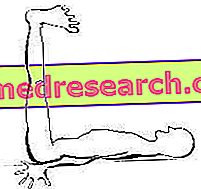By Dr. Ilio Iannone
The Mézières method was invented in 1947 in France by a physiotherapist called Françoise Mézières.

In summary, if the shape of a body is deformed, the function that follows is distorted.
If there are morphological disharmonies there will be compensations and / or bad synergies, therefore potentialities of pathologies and pain.
There is an absolute complementarity between the Mézières method and osteopathy. Same approach / contact of the patient (bones, viscera, fasciae, muscles)
(1) Movement is life, all anatomical structures are moving in relation to each other
(2) The structure determines the function
(3) Homeostasis, which is the body's ability to rebalance and repair itself.
Many times the evil is far from the place of origin, so we must not confuse the cause of the evil and the symptom! (4) A wrongly curved ankle sprain, which leaves as a consequence, for example, a limitation in the width of the flexion, will have to compensate for each step:
- in some subjects to the knee, which will have to stretch a little more and force the ligaments thus generating a pain,
- in others to the hip, whose tissues will no longer be able to withstand compensation (pain in the groin),
- in others again, at the bottom of the spine (sacro-iliac joint) which will be found to be "rubbed" "forced" at each posterior step, pulling the ligaments and sometimes causing lumbago resistant to any local treatment,
- a large number of other compensations may take place in sometimes the most unexpected areas.
A dorsal and thoracic region may be stiff, and thus deprived of its physiological mobility, due to too short breathing (generated by a state of anxiety or permanent anxiety), due to excessively fixed positions in office work, for an old trauma to the back, due to a certain rigid "behavior", due to arthrosis that "nails" the dorsal region a little at a time.
So, whenever you need to look back, do a parking maneuver between two cars, take a sheet of paper behind you in the office, etc., the amount of movement needed will have to be done largely from the cervical spine, from the lumbar region, from the shoulders, and very little from the dorsal column as it is almost blocked.
If the compensating organization is badly divided, the cervicals of one will find themselves overloaded with work and very quickly in pain (cervicalgia, torticollis), the lumbar of the other will have to work in a job for which they do not have a primary vocation and can " to freeze "on the occasion of a so-called" false movement ", the shoulders of another still will have to" force "and, depending on their susceptibility, may generate chronic inflammatory phenomena (peri-arthritis, tendinitis) (2).
It is thus noted that very often the pain appears in areas of compensation and that the real evil remains hidden in the shadows, without manifesting itself.
"evil is never where it manifests itself", dixit Mézières.
The naivety and stupidity of a therapy that addresses only the symptoms in the context of a chronic pathology is thus evident. And even in acute cases, the real cause of your lumbago or torticollis is found in parts other than the lumbar and cervical areas.
It is our duty to find them! (2).
Many times a biomechanical analysis of this kind is not possible: the compensation game is so complex that it becomes impossible to go back to the primary cause. Then the only guide remains the form whose normalization, through the parameters of the "beautiful lines", represents the only strategy in the most intricate cases. It is the achievement of a better form that aims at the Mezieres treatment, through a structural work made of postures (that is, stretching), articulating movements, "undoing" (in which certain muscle groups operate without the "usual bad synergies"). ") (3).
The principles of the method are simple and logical. But the practical updating of a Mézières treatment is much more difficult to achieve! A Mézières treatment requires great precision on the part of the therapist and requires a rigorous and meticulous observation of the whole body in its various adaptive behaviors (4).
The problem is to be able to correct the main lesion, which is the cause of the patient's condition, starting from the multiple dysmorphisms and pains of the latter, correcting the adaptations one after the other in the opposite direction. Often, the main lesions disappear by themselves, when the different adaptations are fixed with even more serious consequences than those that had been caused by the initial lesions. As a result, these can become major injuries and so on ..... The mezier becomes an investigating therapist!
Development of a Mézières treatment:
PURPOSE: - relieve muscle tension - restore the original length of the shortened muscles
MEANS: - placing the patient in positions of global stretching, exercising one
continuous and simultaneous traction at the ends of the muscle chains and preventing, as far as possible, compensations - adaptations (also called cheating).
These global and total positions must be held with great rigor and for a fairly long time (unlike stretching) and associated with an expiratory work that fights the lordosis and lengthens the diaphragm, also a very important muscle for the static .
This expiratory work is an additional and powerful method to intensify the tension of the different shortened muscle chains (4).



